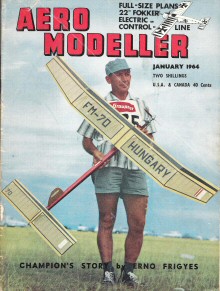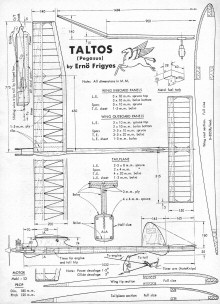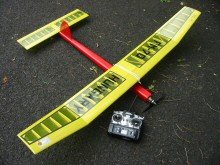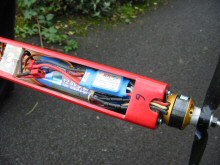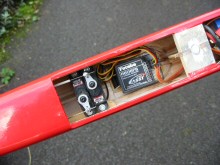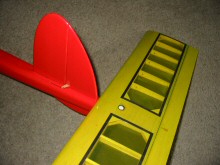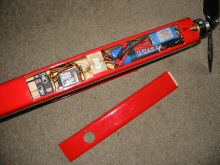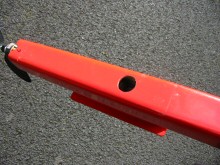|
|||
|
|
|
||
| View Shopping Cart |
| Home |
| Guides Available |
| About the Author |
| FAQs |
| Testimonials |
| Articles |
| Contact Andrew |
| Terms & Conditions |
| Mailing List |
| Links |
 |
 |
Get more high quality electric modeling information, absolutely free:
Sign up for the Gibbs Guides newsletter now!
Taltos by Ray Jennings
A reinterpretation of a classic
vintage 2.5cc contest power design
Article by Ray Jenings
with captions by Andrew Gibbs
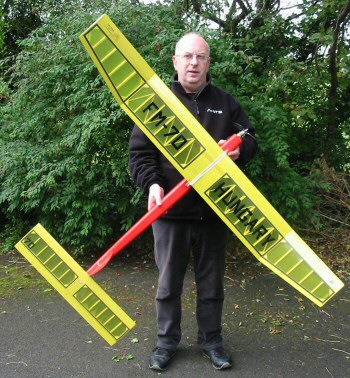
Having converted an enlarged Korda Wakefield to electric power I decided to try the same exercise with an FAI F1C free flight power design. The Korda, which was shown in the February 2008 issue of AMI flies well but is very lightly built and best suited to calm weather flying, whereas a power design would be a little more versatile and rugged.
There are many vintage designs to choose from and a quick look through my collection of old Aeromodellers led me to the cover of the January 1964 issue. This showed the famous Hungarian modeller Erno Frigyes holding his 1963 World Champs winner, the Taltos (Pegasus). Inside the magazine I found a short article and a dimensioned three-view drawing – perfect. I scaled the outline to the actual size (60”span) but simplified and strengthened the structure somewhat.
|
|
Construction was straightforward although I built the tail plane almost entirely from 1/32 balsa to keep it as light as possible. The only cheat was to widen the fuselage slightly to squeeze in all the gear. The covering is World Models Toughlon, red on the fuselage and transparent yellow on wing and tail plane, using a simplified version of the original’s scheme. The finished weight of my model, with its battery is 34ozs. Erno’s Taltos weighed 27ozs.
|
|
Radio used is a 2.4GHz Futaba T6EX with an R606FS receiver and two Hitec HS82MG servos. Motor is an AXI 2808/24 turning a Graupner 9 x 5 Slim Prop and the speed controller is a Jeti Advance 30 Plus.
|
|
To help with the balance I used heavier Saphion cells rather than Lipos, in this case a four cell 12.8v 15C pack of 1,200mAh capacity. This combination, according to my old Astro Flight Wattmeter, produces an input power of 160 Watts. RPM on the 9 x 5 is 9,400. As regards balance, the original used a 68% wing chord CG. This worried me a little so I balanced mine at 60%.
|
|
This type of model is for climbing high and gliding long. It looks ridiculous doing overshoots, hedgehopping and aerobatics. The climb is fast and steep but it’s no hotliner. The motor was selected as theoretically having the equivalent power of a 2.5cc two stroke as used in FAI F1C models. Since I have never actually seen these fly, I don’t know if the climb is realistic or not, but it’s fast enough for me. Just for fun I entered it in a local contest and came second. I think this was mainly due to blundering into good air although the performance seemed to be on a par with a typical two meter electric glider.
In truth the Taltos was my second choice design. I really wanted to build one of Bill Giesking’s futuristic looking flapped designs but fortunately common sense prevailed. But who knows, perhaps next time……….
| Taltos electric power system data 1 x 4S 1,200mAh 15C Saphion battery |
|||||
| Prop RPM (9x5) |
Voltage (on load) |
Current (Amps) |
Power (Watts) |
Pitch speed | |
| Full throttle | 9,400 | 12 | 13 | 160 | n/a |
| Taltos technical data | ||
| Span | 1,524mm | 60 inches |
| Length | TBA | TBA |
| Flying weight |
964g | 2lb 2oz (34oz) |
| Wing Area | 0.29 sq m | 449 sq in |
| Wing Loading | 00 g/dm | 28 oz/sq ft |
| Battery | 1 x 4S 1,200mAh Saphion, rated at 15C | |
| Nominal battery voltage | 12.8V | |
| Motor | AXI 2808/24 | |
| Motor Kv (design RPM/V) | 1,190 | |
| Prop | Graupner 9 x 5 Slim Prop | |
| RPM at full power | 9,400 | |
| Propeller pitch speed | 47mph approx | |
| Current at full power | 13A approx | |
| Max Power | 160W | |
| Power Loading | 158W/kg | 72W/lb |
| Control functions | Rudder, elevator and throttle. | |
